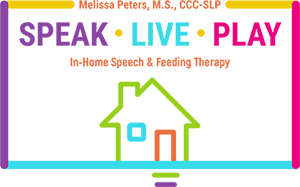Speak Live Play: Nurturing Healthy Relationships with Food through Feeding Therapy
Embarking on the journey of feeding therapy isn’t your typical stroll—it’s a transformative experience that dives into our overall well-being. Let’s take a closer look at feeding therapy, grasp its significance for people of all ages, and discover how it takes on food-related challenges. Feeding therapy is about tailored strategies ensuring proper nutrition for the best growth and development. Ready to dive into this enriching exploration? Let’s get to it!
Importance for Different Age Groups
Feeding therapy is crucial for everyone, from little ones to adults, to build a positive connection with food. It is critical in addressing age-specific challenges and promoting healthy eating habits. Let’s explore how this therapy caters to the distinct needs of different age groups.
Why Feeding Therapy Matters
Feeding therapy matters, and it’s more than just the food on our plates. It plays a crucial role in creating positive relationships with food, impacting our overall well-being. It goes beyond eating; it’s about establishing healthy connections and habits, contributing to a happier life. Learn more.
The Importance of Addressing Feeding Challenges
Getting a handle on feeding challenges right from the start is crucial. It lays the groundwork for forming lasting and healthy eating habits throughout life.
Common Issues Addressed in Feeding Therapy
Feeding therapy deals with a range of issues, from picky eating to texture sensitivities and swallowing difficulties, with a personalized approach. It’s all about finding what works for you.
- Picky Eating and Selective Diets: Being a picky eater sometimes keeps you from getting everything your body needs. Feeding therapy steps in with smart tricks to help you broaden your food horizons, ensuring you get a good mix of nutrients for a healthy and balanced diet.
- Texture Sensitivities: Texture sensitivities can add a twist to mealtime, making it tricky. Luckily, feeding therapy uses sensory tricks to make different food textures more familiar and enjoyable.
- Swallowing Difficulties: Both infants and grown-ups can face issues with swallowing. Feeding therapy provides tailored solutions to improve swallowing skills. If you or your little one is struggling with this, read on to discover how feeding therapy can make a real difference.
The Role of Rehabilitation Centers in Feeding Therapy
Rehabilitation centers are vital in transforming feeding challenges through specialized programs and collaborative efforts with healthcare professionals.
- Specialized Programs and Services: Our rehab centers offer targeted programs addressing diverse feeding issues. We ensure a thorough and personalized approach to cater to your unique needs.
- Collaborative Approach with Healthcare Professionals: Our healthcare professionals adopt a collaborative approach in feeding therapy. Together, we blend our skills to provide comprehensive assistance, ensuring a holistic journey towards success.
- The Role of Feeding Therapy in Child Development: Feeding therapy isn’t just a quick fix; it’s crucial to setting up a healthy future for kids. When we step in early, during infancy and childhood, feeding therapy becomes a force that shapes enduring habits for a lifetime of wholesome eating.
- Nurturing Healthy Eating Habits in Children: Feeding therapy isn’t just about tackling eating issues; it’s about shaping healthy habits in children. It goes beyond the surface, building a positive food outlook that stays with them as they grow.
Regarding child development, feeding therapy is crucial, ensuring each nibble contributes to physical growth and a lifelong positive bond with food. Ready to explore this journey with us?
Assessment and Diagnosis in Feeding Therapy
Nailing down the specifics through careful evaluation sets the stage for effective treatment in feeding therapy. Think of it as your personalized roadmap, navigating the unique twists and turns of someone’s food journey.
Getting to the root causes of feeding therapy is like being a detective. Picture yourself in a detective hat, uncovering the reasons behind picky eating or swallowing challenges. This detective work is the essential groundwork, shaping a treatment plan as unique as a fingerprint.
- Identifying Underlying Causes: The first step in addressing feeding challenges is a comprehensive assessment. This crucial process reveals the root causes, paving the way for precise and effective intervention strategies.
- Tailored Treatment Plans: Once the puzzle pieces are in place, feeding therapy crafts personalized treatment plans. These plans are uniquely designed for each individual, honing in on specific needs to ensure successful outcomes.
- Understanding the Basics of Feeding Therapy Programs: Understanding the basics of feeding therapy programs makes the journey more manageable. It acts as a compass for individuals and families, providing insights into what to expect and how the process unfolds.
- Components of a Feeding Therapy Session: Every session combines carefully chosen elements. We seamlessly blend sensory experiences and strategic behavior approaches, ensuring each session is practical and enjoyable for everyone involved.
- Tailoring Programs to Individual Needs: The charm of feeding therapy is in how it’s all about you—crafted to fit your needs and likes.
Incorporating Fun and Engagement in Feeding Therapy
Speak, live, play—it’s not just a mantra; it’s the essence of making feeding therapy an enjoyable and positive experience.
- Importance of Play in the Process: In feeding therapy, play isn’t just a pastime—it’s a vital ingredient in making mealtime fun and interactive. Let’s explore why incorporating play into the feeding therapy journey is more than a game.
- Creating a Positive Food Environment: Imagine a cheerful space full of support where the love for food flourishes. Feeding therapy understands the importance of this setting, establishing a haven where people can enjoy the pleasure of eating in a warm and inviting environment.
- Breaking Myths Surrounding Feeding Therapy: Embarking on the journey of feeding therapy means tackling misconceptions head-on. Feeding therapy is here to challenge myths, clearly understand their positive impact, and break down barriers that might hinder individuals from seeking the help they need.
- Dispelling Misconceptions: It’s time to set the record straight. Feeding therapy doesn’t just address misconceptions; it dismantles them. By providing clarity and debunking myths, feeding therapy paves the way for a more informed and open approach to fostering healthy relationships with food.
- Breaking Stereotypes with Inspiring Success Stories: Feeding therapy isn’t just a process; it’s a journey filled with success stories that challenge stereotypes. These stories are a testament to the incredible impact of feeding therapy, proving that positive outcomes are achievable and defy common misconceptions.
Feeding Therapy Techniques and Approaches
Feeding therapy employs various techniques and approaches, emphasizing behavioral strategies, sensory integration methods, and a playful approach to make mealtime enjoyable.
- Behavioral Strategies: Let’s talk about behavioral strategies in feeding therapy. These strategies aim to guide individuals toward positive food behaviors, nudging them to be more open to exploring and trying new things.
- Sensory Integration Methods: Now, let’s delve into sensory integration methods. These methods are like superpowers in overcoming texture sensitivities, making the experience of different food textures more manageable and less daunting.
- Engaging Techniques in Feeding Therapy: Feeding therapy doesn’t have to be dull. Enter engaging techniques, where interactive activities and games join the party, turning therapy sessions into lively and enjoyable experiences.
- The Playful Approach: Picture this – a playful approach to feeding therapy. It’s not just about food; it’s about incorporating games and activities into the mix, creating a positive and fun connection with meals. Because who said therapy can’t be playful?
- Making Mealtime Enjoyable: The main aim is to turn mealtime into a joyful experience, promoting a positive bond with food that lasts well beyond therapy sessions. Transitioning from a chore to a delight, we focus on making the dining experience a source of pleasure and connection.
Feeding Therapy at Home: Tips for Parents
Play a vital role in the success of feeding therapy, encompassing the establishment of wholesome eating habits, reinforcement of positive behaviors, and adeptly navigating potential challenges.
- Establishing Good Eating Habits: In the comfort of home, parents play a crucial role in carrying forward the principles of feeding therapy. Actively promoting and reinforcing healthy eating habits is key to this ongoing process.
- Encouraging Positive Behaviors: Parents can guide their children toward developing a healthy relationship with food by harnessing the power of positive reinforcement. A positive and supportive environment is created by reinforcing positive behaviors around meals.
- Navigating Challenges and Celebrating Victories: The journey of feeding therapy involves acknowledging challenges and celebrating victories, whether big or small. This continuous process contributes to the overall success of the therapy.
- Facing and Overcoming Resistance: It’s natural to encounter resistance in the feeding therapy journey. However, feeding therapy provides parents with practical strategies to overcome resistance, ensuring sustainable progress.
- Celebrating Milestones: Every step forward is a reason to cheer. Feeding therapy is all about embracing and commemorating every accomplishment, regardless of size. This approach urges parents to enjoy their child’s progress, fostering a positive and encouraging atmosphere.
Success Stories from Feeding Therapy Programs
Real-life transformations and testimonials from parents and caregivers underscore the impact of feeding therapy, highlighting the collaborative journey and the supportive role of healthcare professionals.
- Real-Life Transformations: Witnessing real-life transformations is a true testament to the effectiveness of feeding therapy, sparking hope for those grappling with challenges. These success stories vividly depict the positive outcomes achievable through dedicated efforts.
- Testimonials from Parents and Caregivers: Gaining insights from the heartfelt experiences of parents and caregivers is like tapping into a treasure trove of wisdom. These testimonials provide a glimpse into the collaborative journey of feeding therapy, offering valuable perspectives that resonate with those navigating similar paths.
- Feeding Therapy: A Collaborative Journey: Feeding therapy is far from a solo mission; it’s a joint expedition where parents, caregivers, and healthcare professionals unite for positive outcomes. This collaborative approach creates a supportive ecosystem, fostering an environment where individuals undergoing treatment can thrive.
- Involvement of Parents and Caregivers: The active participation of parents and caregivers is a cornerstone in feeding therapy. Their involvement not only enriches the overall experience but also establishes a robust support system, contributing significantly to the success of individuals in their treatment journey.
- The Supportive Role of Healthcare Professionals: Healthcare professionals play a crucial role, providing expertise, guidance, and support throughout the feeding therapy process.
The Evolution of Feeding Therapy: Current Trends
Feeding therapy continually evolves, embracing technological advancements, and telehealth options, and addressing challenges while adapting to individual needs.
- Technological Advancements: Technology enhances the reach and effectiveness of feeding therapy, providing innovative solutions to make interventions more accessible.
- Telehealth and Remote Sessions: Telehealth brings feeding therapy directly into homes, offering remote sessions that ensure continuity of care and accessibility.
- Facing Hurdles in Feeding Therapy: Embracing challenges is the first step toward improvement. Feeding therapy directly confronts these challenges, tailoring its methods to fit each person’s needs.
- Tailoring to Individual Needs: The secret sauce is customization. Feeding therapy understands that everyone is different, tweaking strategies to ensure the best outcomes based on individual requirements.
- Navigating Resistance: Conquering resistance is a continuous journey. Feeding therapy provides individuals the skills to navigate obstacles, fostering a constructive connection with food.
Empowering Parents as Partners in Feeding Therapy
Empowering parents involves:
- Providing educational resources.
- Encouraging active involvement in the treatment process.
- Highlighting the holistic impact of feeding therapy on physical and psychological well-being.
Educational Resources for Families: Access to educational resources empowers families, providing valuable information to understand and navigate the feeding therapy journey.
Parental Involvement in the Treatment Process: Active parental involvement enhances the effectiveness of feeding therapy, fostering a supportive environment for individuals undergoing treatment.
Feeding Therapy: A Holistic Approach: Feeding therapy is not just about addressing immediate challenges; it’s a holistic approach that positively impacts physical health and enhances psychological well-being.
Impact on Physical Health: Improved physical health directly results from effective feeding therapy, ensuring individuals receive the nutrition needed for overall well-being.
Enhancing Psychological Well-being: The positive impact of feeding therapy extends beyond the physical, enhancing psychological well-being through improved eating habits and a positive relationship with food.
The Connection Between Feeding Therapy and Overall Well-being
The intricate connection between feeding therapy and overall well-being is evident in the improved physical health and the psychological and emotional benefits it brings.
- Impact on Physical Health: Feeding therapy directly influences physical health by addressing challenges and ensuring individuals receive the necessary nutrients for optimal well-being.
- Psychological and Emotional Benefits: Beyond the plate, feeding therapy contributes to psychological and emotional well-being, fostering a positive relationship with food and promoting a healthy mindset.
- Exploring the Future of Feeding Therapy: Let’s dive into what’s coming next in feeding therapy, where exciting trends are shaping up. From fancy tech upgrades to ongoing research, these changes are all geared toward making feeding therapy even more effective and accessible.
- Tech Boosts in Feeding Therapy: In the future, technology will step up its game in feeding therapy. Imagine excellent tools and gadgets making assessments, interventions, and support super intelligent and user-friendly.
- Unleashing the Power of Research: Feeding therapy is not just a here-and-now thing; it’s evolving constantly. Ongoing research is the driving force, ensuring our approaches are solid, backed by evidence, and perfectly tailored to each person’s unique needs.
So, what’s in store for feeding therapy? It’s all about getting tech-savvy and staying ahead with the latest research to ensure everyone gets the support they need. The future looks promising!
Future Outlook: Innovations in Feeding Therapy
Exploring the Future: Constant research and development play a vital role in keeping up with the latest breakthroughs in feeding therapy. Staying in the loop ensures we can provide the best care possible.
Global Unity for Better Access: By joining hands in global initiatives and collaborations, we can enhance access to feeding therapy worldwide. Let’s make a collective effort for a more significant and widespread impact.
Embracing Food Harmony: To sum it up, feeding therapy goes beyond overcoming challenges; it’s about cultivating healthy connections with food. It’s a journey towards positive attitudes and a lifelong promise of well-being. Let’s nourish these relationships together!
Encouragement for Seeking Professional Help
Encouraging individuals to seek professional help emphasizes the ongoing support and guidance available in their feeding therapy journey.
Speak, live, play—let feeding therapy be the transformative journey towards a healthier and happier you. Contact us today!





